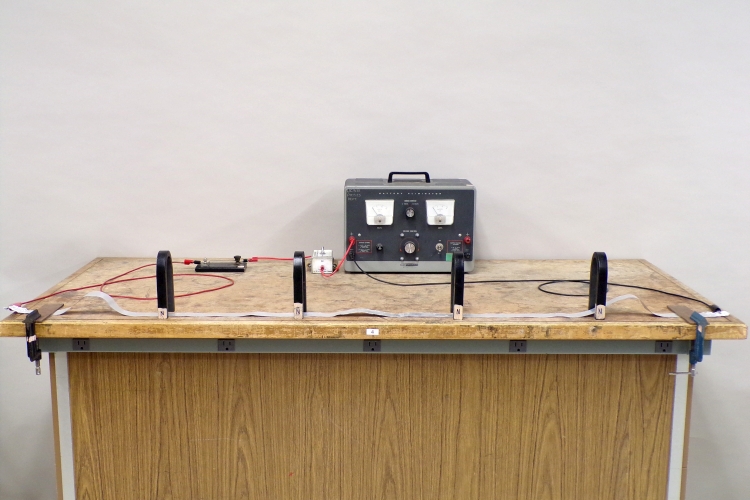
With the power supply on, and the foil connected and the magnets oriented as shown in the photograph, when you depress the tap switch, the aluminum foil rises from the table. If you switch the direction of one or more of the magnets, when you press the tap switch, the foil there is pressed against the table. If you reverse the current, the foil behaves in the opposite way.
An electric charge passing through a magnetic field experiences a (sideways) force, F = qv × B, where q is the magnitude of the charge, v is its velocity, and B is the magnetic field. The magnitude of the the force is qvB sin θ, where θ is the angle between v and B. When the charge is traveling parallel to the magnetic field, then, this force is zero, and when v is perpendicular to B, it is maximum (F = qvB). If the charge is part of a current, i, flowing in a wire, then the wire feels a force of F = il × B, where l is the length of the part of the wire that is in the magnetic field. (For simplicity, we are assuming that this part of the wire is straight.) If the wire is perpendicular to the magnetic field, this force is F = ilB.
In this demonstration, a strip of aluminum foil runs between the poles of four U magnets placed at intervals along its length. As shown in the photograph, the north pole of each magnet is next to the front edge of the foil strip, and the south pole of each magnetic is behind the back edge of the strip. The magnetic field, B, then, points toward the back of the table. With the foil connected as shown, when the power supply is on and you close the tap switch, the current (which by convention refers to the flow of positive charge) flows through the strip from the left end to the right end. qv × B thus points upward, as does il × B, and the aluminum foil rises. If you reverse one or more of the magnets, the magnetic field at each of those magnets now points toward the front of the table, which reverses the direction of qv × B and il × B, and when you press the tap switch, the foil lies flat against the table under those magnets. If we consider electron flow, v now points toward the left, but q is negative, so qv × B and il × B still point upward under the magnets as they are shown above, and downward under a magnet whose poles are oriented in the opposite direction.
If you reverse the current, either by exchanging the alligator clips or by switching the plugs at the power supply, the behavior of the foil strip is opposite to that described above. Now, with the magnets facing as shown in the photograph, the foil is pressed against the surface of the table when you close the tap switch, but if you turn the magnets so that their north poles face the back of the table, when you press the switch, the foil rises.
References:
1) David Halliday and Robert Resnick. Physics, Part Two, Third Edition (New York: John Wiley and Sons, Inc., 1978), pp. 718-22.